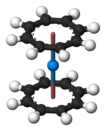 Skeletal formula
Skeletal formula Ball-and-stick
Ball-and-stick Space-fillingUranocene molecular representations showing the U atom sandwiched between 2 COT ligands
Space-fillingUranocene molecular representations showing the U atom sandwiched between 2 COT ligands
Actinocenes are a family of organoactinide compounds consisting of metallocenes containing elements from the actinide series. They typically have a sandwich structure with two dianionic cyclooctatetraenyl ligands (COT, which is C
8H
8) bound to an actinide-metal center (An) in the oxidation state IV, resulting in the general formula An(C8H8)2.
Characterised actinocenes
| Name | Formula | An centre | First synthesis | Crystal colour | An–COT distance (Å) | Space group |
|---|---|---|---|---|---|---|
| Thorocene | Th(C8H8)2 | Th | 1969 | bright yellow | 2.004 | P21/n |
| Protactinocene | Pa(C8H8)2 | Pa | 1974 | yellowish | – | P21/n |
| Uranocene | U(C8H8)2 | U | 1968 | deep green | 1.926 | P21/n |
| Neptunocene | Np(C8H8)2 | Np | 1970 | yellow-brown | 1.909 | P21/n |
| Plutonocene | Pu(C8H8)2 | Pu | 1970 | dark red | 1.898 | I2/m |
The most studied actinocene is uranocene, U(C8H8)2, which in 1968 was the first member of this family to be synthesised and is still viewed as the archetypal example. Other actinocenes that have been synthesised are protactinocene (Pa(C8H8)2), thorocene (Th(C8H8)2), neptunocene (Np(C8H8)2), and plutonocene (Pu(C8H8)2). Especially the latter two, neptunocene and plutonocene, have not been extensively studied experimentally since the 1980s because of the radiation hazard they pose.
Bonding
The actinide-cyclooctatetraenyl bonding has been of interest for multiple theoretical studies. Computational chemistry methods indicate bonding with a large covalent character resulting mainly from the mixing of actinide 6d orbitals with ligand π-orbitals, with a smaller interaction involving the actinide 5f and ligand π-orbitals. The covalent component is characterised by donation of electron density to the actinide.
Analogous sandwiched M(C8H8)2 compounds also exist for lanthanides M = Nd, Tb, and Yb, but therein the bonding is mostly ionic rather than covalent (see lanthanocenes).
See also
References
- Minasian, Stefan G.; Keith, Jason M. (2014). "New evidence for 5f covalency in actinocenes determined from carbon K-edge XAS and electronic structure theory". Chem. Sci. 5 (1): 351–359. doi:10.1039/C3SC52030G.
- ^ Greenwood, Norman N.; Earnshaw, Alan (1997). Chemistry of the Elements. Butterworth-Heinemann. pp. 1278–1280. ISBN 978-0-08-037941-8.
- ^ Seyferth, D. (2004). "Uranocene. The First Member of a New Class of Organometallic Derivatives of the f Elements". Organometallics. 23 (15): 3562–3583. doi:10.1021/om0400705.
- Goffart, J.; Fuger, J.; Brown, D.; Duyckaerts, G. (1974-05-01). "On the cyclooctatetraenyl compounds of actinide elements part II. Bis-(cyclooctatetraenyl) protactinium(IV)". Inorganic and Nuclear Chemistry Letters. 10 (5): 413–419. doi:10.1016/0020-1650(74)80119-4. ISSN 0020-1650.
- Avdeef, Alex; Raymond, Kenneth N.; Hodgson, Keith O.; Zalkin, Allan (1972-05-01). "Two isostructural actinide .pi. complexes. Crystal and molecular structure of bis(cyclooctatetraenyl)uranium(IV), U(C8H8)2, and bis(cyclooctatetraenyl)thorium(IV), Th(C8H8)2". Inorganic Chemistry. 11 (5): 1083–1088. doi:10.1021/ic50111a034. ISSN 0020-1669.
- De Ridder, D. J. A.; Rebizant, J.; Apostolidis, C.; Kanellakopulos, B.; Dornberger, E. (1996-03-15). "Bis(cyclooctatetraenyl)neptunium(IV)". Acta Crystallographica Section C: Crystal Structure Communications. 52 (3): 597–600. doi:10.1107/S0108270195013047. ISSN 0108-2701.
- ^ Windorff, Cory J.; Sperling, Joseph M.; Albrecht-Schönzart, Thomas E.; Bai, Zhuanling; Evans, William J.; Gaiser, Alyssa N.; Gaunt, Andrew J.; Goodwin, Conrad A. P.; Hobart, David E.; Huffman, Zachary K.; Huh, Daniel N. (2020-09-21). "A Single Small-Scale Plutonium Redox Reaction System Yields Three Crystallographically-Characterizable Organoplutonium Complexes". Inorganic Chemistry. 59 (18): 13301–13314. doi:10.1021/acs.inorgchem.0c01671. ISSN 0020-1669. OSTI 1680020. PMID 32910649. S2CID 221623763.
- ^ Apostolidis, Christos; Walter, Olaf; Vogt, Jochen; Liebing, Phil; Maron, Laurent; Edelmann, Frank T. (2017-04-24). "A Structurally Characterized Organometallic Plutonium(IV) Complex". Angewandte Chemie International Edition. 56 (18): 5066–5070. doi:10.1002/anie.201701858. PMC 5485009. PMID 28371148.
- ^ Kerridge, Andrew (2014). "f-Orbital covalency in the actinocenes (An = Th–Cm): multiconfigurational studies and topological analysis" (PDF). RSC Advances. 4 (24): 12078–12086. Bibcode:2014RSCAd...412078K. doi:10.1039/C3RA47088A.
| Thorium compounds | |
|---|---|
| Th(II) | |
| Th(III) | |
| Th(IV) | |